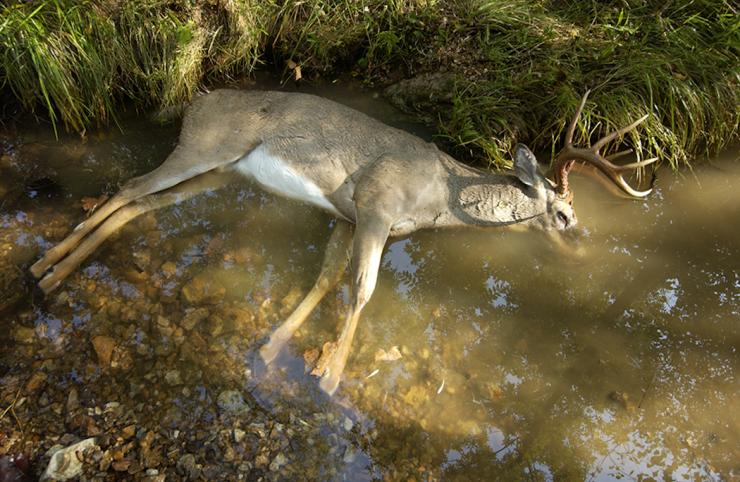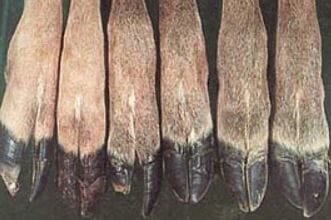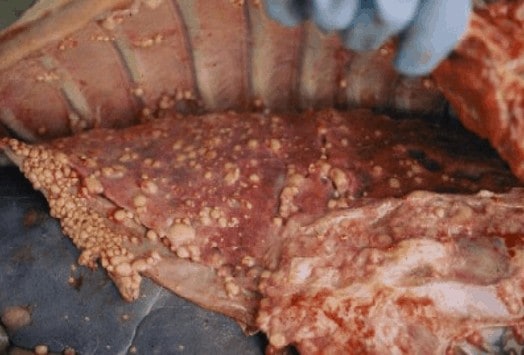Whitetail populations are susceptible to a variety of diseases and parasites. Every year it seems that we have some type of outbreak that puts deer around the country at risk. Although most diseases whitetails get are harmless to humans, knowing what these ailments look like could help you better manage your deer. It would also help avoid eating deer that you should not. Along with providing good nutritional value, some whitetail supplements can be a preventative measure to these diseases. Certain supplements contain helpful additions such as anti-bacterial, anti-inflammatory, anti-fungal, and anti-viral benefits.
RELATED POST: WHITETAIL MINERAL SUPPLEMENTS | NOT JUST SALT
1) Hemorrhagic Disease (HD)
HD is one of the most common types of viral whitetail diseases that can be deadly. It has multiple strains including Epizootic hemorrhagic disease (EHD), and Blue Tounge. This year, EHD has made a large outbreak and started a buzz. Much like the CWD outbreak last year in 2018.
Hemorrhagic Disease is a viral infection spread to whitetail deer by small flys known as biting midges. These insects are also called regional names such as sand gnats, sand flies, no-see-ums and punkies. These gnats are generally more abundant during droughts, or in areas with large amounts of mud. An Infected deer may or may not show symptoms. Some deer can carry the virus for months or years and not show symptoms, while others show symptoms within days.

These are the signs of HD according to Dr. Howarth of Iowa State University,
“In general, deer infected with EHD lose their appetite, lose their fear of people, grow weak, show excessive salivation, develop a rapid pulse, have a rapid respiration rate. They also show signs of a fever which include lying in bodies of water to reduce their body temperature, become unconscious, and have a blue tongue from the lack of oxygen in the blood”. It is truly one of the worst whitetail diseases.
Risk to Humans

HD is not transferable to humans. So, the animal is safe to eat, but personally, I would not eat it if I did not have to. If you see an outbreak of HD on your property the only choice you have is to let it run its course. As of 2019, there is not a cure for all the whitetail diseases that HD contains. Sadly, if your population of whitetail does contract the disease you can expect around 25%-30% death from the disease. Some report numbers as high as 50% death.
2) Chronic Wasting Disease (CWD)
Chronic wasting disease (CWD) is a prion disease that affects elk or Wapiti, red deer, mule deer, black-tailed deer, white-tailed deer, Sika deer, reindeer, and moose. CWD is present in some areas of North America, including Canada and the United States, Norway, and South Korea. It may take over a year before an infected animal develops symptoms. Which can include drastic weight loss (wasting), stumbling, listlessness, abnormal behavior, and loss of bodily functions. CWD can affect animals of all ages and some infected animals may die without ever developing the disease. CWD is spread through the contact of bodily fluids. It is 100% fatal to animals and there are no treatments or vaccines. (Center for Disease Control)

Other Places We See CWD
“CWD belongs to a group of diseases known as transmissible spongiform encephalopathies (TSEs). Within this family of diseases, several other variants affect domestic animals. Scrapie, which has been identified in domestic sheep and goats for more than 200 years. Bovine Spongiform Encephalopathy (BSE) in cattle (also known as “mad cow disease”), and transmissible mink encephalopathy in farmed mink. ” (CWD-info.org)
Risk to Humans
As of 2019, there have not been any cases of Chronic Wasting Disease being transferred to humans. Although there have been other cases of CWD being transferred to primates. They ate infected meat or came in contact with body fluids from the infected animal. The World Health Organization has strongly suggested to not consume animals infected with Chronic Wasting Disease, even though there have not been any reported cases in Humans.
3) Bovine Tuberculosis
“Bovine tuberculosis (bovine Tb) is a disease found in mammals caused by the bacteria Mycobacterium bovis (M. bovis). In North America, bovine Tb is most commonly found in domestic cattle, captive and wild cervids (white-tailed deer, elk, etc.). However, it is less common in other mammals such as raccoons, opossums, coyotes, and wild boars. ” (Perdue University)
Bovine Tb causes the animal to have issues with its respiratory system and can cause high fevers. The disease is spread through bodily secretions like urine, feces, blood, breast milk, or saliva. With the correct environment, the bacteria can live for months and infect mammals that come in direct contact with it. This is one reason that baiting deer in high-risk Tb locations has became illegal. The deer can feed at these piles and leave saliva on other bits of food. As a result, healthy whitetails ingest infected food.

Photo: Michigan DNR
Risk to Humans
While highly unlikely it is technically possible for humans to contract TB from Whitetails. If you harvest a whitetail in a TB prevalence zone, you should avoid eating organs. Cooking the meat thoroughly is the best precaution. The recommended cooking requirement is a temperature of at least 165 degrees F. When a deer is infected cooking at this temperature will kill all bacteria.
4) Cutaneous Fibroma / Deer Warts
Cutaneous Fibroma is a viral infection spread by insects that typically infects 0.4% – 2.4% of deer. Most deer are around the age of 2 years old when this happens (Journal of the American Veterinary Medical Association). They are brown/black lumps that grow on the deer but rarely grow beneath the skin.

Deer warts are a common occurrence throughout the country. Seemingly every population has seen them to some degree. Cutaneous Fibromas are one of the harmless whitetail diseases. These tumors can grow on all parts of the body. The only way these become dangerous is if they begin to inhibit sight, breathing, eating, or the ability to walk. Otherwise, these warts are harmless to the deer and can eventually go away.
Risk to Humans
The most-reported deer illness in the United States of America every year is fibromas. Under normal circumstances, a hunter probably will not even see warts until further inspection after the kill. Not to worry, these Cutaneous Fibromas do not affect the edibility of the deer. They are 100% harmless to humans, other than the gross aesthetic nature.
5) Brain Abscesses
A brain abscess is a bacterial infection that gets into a wound close to the head. This bacteria makes its way to the brain, where it then creates pockets of puss that can not drain out. Arcanobacterium Pyogenes most commonly cause this type of infection. This type of bacteria is not uncommon and can live on the skin or gums of cervids. The bacteria enters through an open wound, which for whitetail bucks could be a scrape on a velvet antler. It can also enter the pedicle (base of the antler) of a shed or damaged antler.
RELATED POST: WHY SHED TRAPS ARE A BAD IDEA

“Nearly 90 percent of all documented cases of brain abscesses have been from bucks. Especially mature bucks greater than 3.5 years old,” (Chas Moore, Alabama Division of Wildlife and Freshwater Fisheries). When a whitetail gets a brain abscess, it is normally fatal. One of the main reasons for non-Human-related death among older bucks is these abscesses. Some symptoms of a brain abscess are abnormal activity, loss of appetite, blindness, and fearlessness of humans or predators. They are basically just a pocket of puss endlessly growing in the deer’s brain. This causes immense pressure and can be very painful. If they keep growing the deer will eventually die.
Thanks for reading my article about common whitetail diseases. I hope you enjoyed it and learned something you didn’t already know. If you like my content, subscribe to my weekly update. If you have any other questions about whitetail diseases or just want to connect, feel free to email me at Patrick.Long@omegaoutdoors.net.
